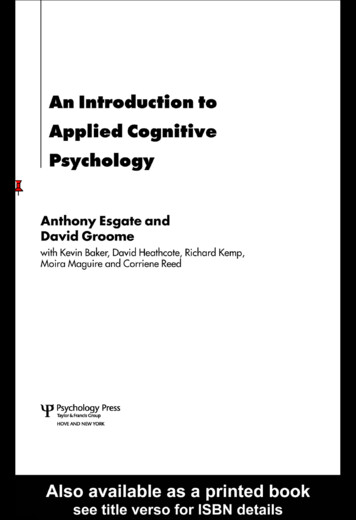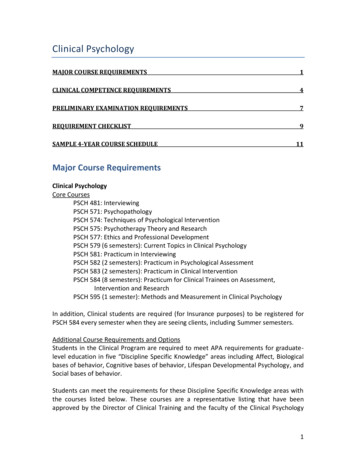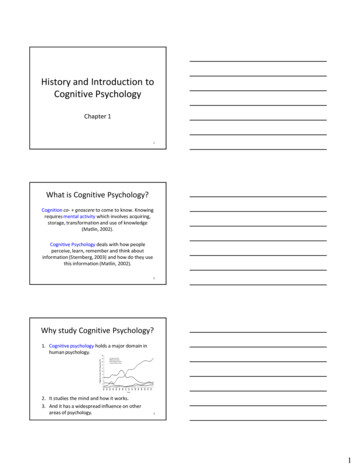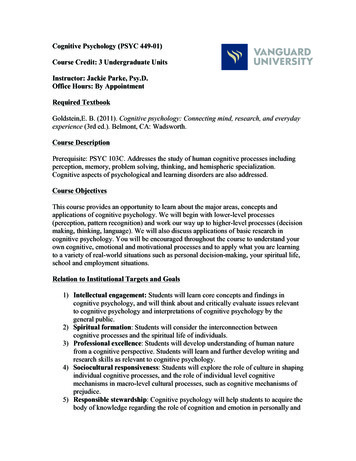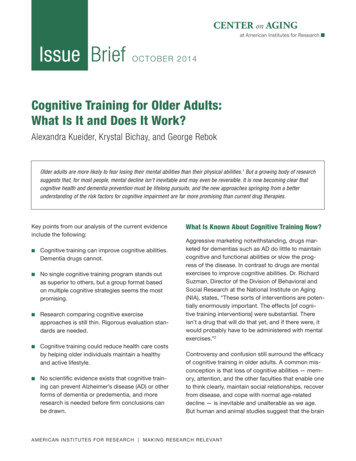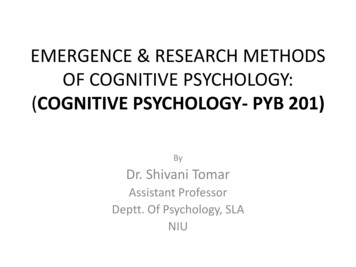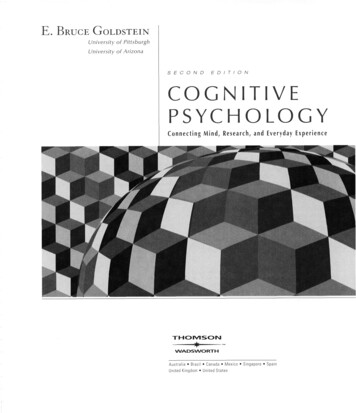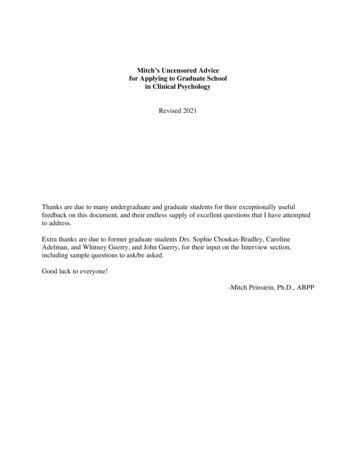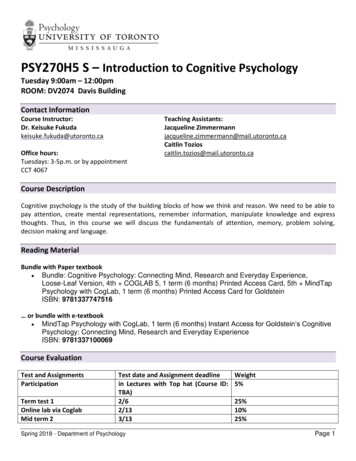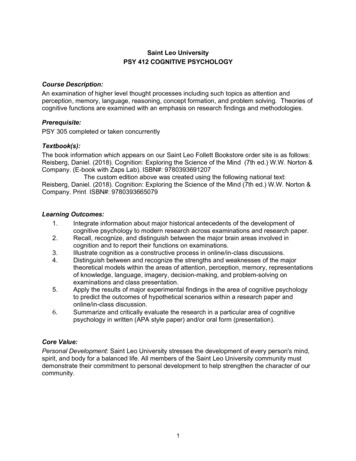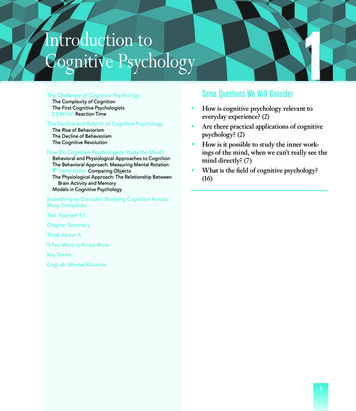
Transcription
Introduction toCognitive PsychologySome Questions We Will ConsiderThe Challenge of Cognitive PsychologyThe Complexity of CognitionThe First Cognitive PsychologistsMethod: Reaction TimeThe Decline and Rebirth of Cognitive PsychologyThe Rise of BehaviorismThe Decline of BehaviorismThe Cognitive Revolution How is cognitive psychology relevant toeveryday experience? (2) Are there practical applications of cognitivepsychology? (2) How is it possible to study the inner workings of the mind, when we can’t really see themind directly? (7) What is the field of cognitive psychology?(16)How Do Cognitive Psychologists Study the Mind?Behavioral and Physiological Approaches to CognitionThe Behavioral Approach: Measuring Mental RotationDemonstration: Comparing ObjectsThe Physiological Approach: The Relationship BetweenBrain Activity and MemoryModels in Cognitive Psychology1Something to Consider: Studying Cognition AcrossMany DisciplinesTest Yourself 1.1Chapter SummaryThink About ItIf You Want to Know MoreKey TermsCogLab: Mental Rotation1
Sarah is walking across campus. She stops for a moment to talk with a friend aboutthe movie they saw last night. She can’t talk for long because she has an appointment to plan her schedule for next term, so she says good-bye and heads off toward heradvisor’s office.This minor event in Sarah’s life is just one occurrence on a typical day. But if westop for a moment to consider what’s involved in this simple sequence of events, we seethat beneath the simplicity lies mental processes such as the following: Perception. Sarah is able to find her way through campus, recognize herfriend, and hear her speak.Attention. As she walks across campus, she focuses on only a portion of herenvironment, but seeing her friend captures her attention.Memory. Sarah remembers her friend’s name, that she has an appointment,and how to fi nd her way to her advisor’s office. She fi nds it interesting thatalthough she and her friend saw the same movie, they remember differentthings about it.Language. She talks with her friend about the movie they saw last night.Reasoning and decision making. Sarah needs to decide which courses to takeand, soon, what to do after graduation. Should she go to graduate school orstart looking for a job?Not only is it easy to provide examples of cognition in everyday experience, but it isalso easy to find examples in the news. Perception. Thousands of deaf people have had a cochlear implant operationthat enables them to hear. Researchers are also working to develop devicesthat would provide sight to the blind.Attention. Researchers testify at a hearing of the New York State legislature that cell phones distract attention from driving. The legislature agreesand bans the use of cell phones while driving in New York (see y. Memory researchers search for ways to prevent the memory lossesthat are associated with aging. Also, research studies show that a largenumber of innocent people have been convicted of crimes based on faultymemory by eyewitnesses at crime scenes.Problem solving and reasoning. Experts ponder evidence to determine thecause of the disintegration of the space shuttle Columbia as it reentered theatmosphere on February 1, 2003.Each of the items on the preceding lists are aspects of cognition—the mental processes that are involved in perception, attention, memory, problem solving, reasoning,and making decisions. Cognitive psychology is the branch of psychology concernedwith the scientific study of cognition.2Chapter 1
The Challenge of Cognitive PsychologyHow can we go beyond simply labeling different aspects of cognition, as we did forSarah’s walk across campus and the examples of cognition in the news? One approachwould be to apply common sense and everyday observation to cognitive phenomena.This might lead to observations about things such as techniques that work for studying,for remembering what to do later in the day, or for solving certain types of problems.It might also lead us to conclude that cognitive tasks that we carry out almost effortlessly, such as perceiving forms or colors or paying attention to important things in theenvironment, are so straightforward and simple that there is little to study about howthey operate. But before we decide that cognition is either obvious or simple, we shouldconsider the following observation by memory researcher Endel Tulving (2001): “Muchof science begins as exploration of common sense, and much of science, if successful,ends if not in rejecting it, then at least going far beyond it” (p. 1505).Tulving’s statement is what this book is about—how science has refi ned and expanded on our everyday explanations of cognition based on common sense. As we explore this idea, we will see that many of the processes involved in cognition are complexand often hidden from view.The Complexity of CognitionMany of the cognitions we listed to describe Sarah’s behavior occurred without much effort on her part. She easily perceived the scene around her and recognized her friend. Ittook a little more effort to remember some of the details of the movie she saw the nightbefore, but she also accomplished this without much difficulty. However, when cognitive psychologists look more closely at processes such as these, they find that beneaththis ease and apparent simplicity lie complexities that may not be initially obvious.To illustrate some of these complexities, let’s consider attention. As Sarah walkedthrough campus, her eyes were flooded with images, but she attended closely to just afew. Thus, as she waved to her friend (Figure 1.1), she was hardly aware of the womanwith the scarf, even though she was clearly visible. This situation enables us to pose thefollowing question: Even though both people are clearly present in Sarah’s field of view,what causes her to be very aware of her friend, but hardly aware of the other person?Here’s another example from everyday experience: Have you ever returned toa place after many years away, and remembered things you hadn’t thought about foryears? When I asked students in my class to write about an experience that involvedmemory, one of my students related the following experience.When I was eight years old, both of my grandparents passed away. Their house wassold, and that chapter of my life was closed. Since then I can remember general thingsabout being there as a child, but not the details. One day I decided to go for a drive. Iwent to my grandparents’ old house, and I pulled around to the alley and parked. AsInt roduc tion to Cog nitive Ps ycholog y3
Bruce Goldstein Figure 1.1 AsSarah waves to herfriend, she is onlyslightly aware of thewoman wearing thescarf, even thoughthat woman is clearlyvisible.I sat there and stared at the house, the most amazing thing happened. I experienceda vivid recollection. All of a sudden, I was eight years old again. I could see myself inthe backyard, learning to ride a bike for the fi rst time. I could see the inside of thehouse. I remembered exactly what every detail looked like. I could even rememberthe distinct smell. So many times I tried to remember these things, but never so vividly did I remember such detail. (Angela Paidousis)Angela’s experience demonstrates that although it is sometimes difficult to remember things, returning to the place where the memories were originally formed can reveal memories that were there all along. These examples illustrate that experiences suchas attention and memory (and other cognitions, as well) involve “hidden” processes wemay not be aware of. One way of thinking about these hidden processes is to draw ananalogy between what happens as an audience watches a play at the theater and how themind works. At a play, the audience’s attention is focused on the drama being created bythe actors, but there is a great deal of activity backstage that the audience is unaware of.Some actors are changing costumes, others are listening for their cues, and stagehandsare moving sets into place for the next scene change. Just as a great deal of activity occurs backstage in a play, a great deal of “backstage” activity occurs in your mind.One of the goals of this book is to show you how cognitive psychologists have revealed the hidden processes that occur “behind the scenes.” This chapter tells the beginning of a story of cognitive psychology research that began over 100 years ago, evenbefore the field of psychology was formally founded. To give us perspective on wherecognitive psychology is today, it is important to see where it came from, and so we willbegin by describing some of the pioneering research on the mind that began in the 19th4Chapter 1
The first cognitivepsychologists How did research on the mind begin? Who were the pioneers?Cognitive psychologyfades from view How did an approach calledbehaviorism discourage the study ofthe mind?The science of themind is rebornModern approachesto the study ofthe mind Figure 1.2Flow diagram forthis chapter. What was behind the “cognitive revolution”that established cognitive psychology as amajor area in psychology? How is the mind studied today?century (Figure 1.2). We then consider the first half of the 20th century, when studyingthe mind became unfashionable; the second half of the 20th century, when the study ofthe mind began to flourish again; and how psychologists and researchers in other fieldsapproach present-day research on the mind.The First Cognitive PsychologistsCognitive psychology research began in the 19th century before there was a field calledcognitive psychology—or even, for that matter, psychology. In 1868, eleven years before the founding of the first laboratory of scientific psychology, Franciscus Donders, aDutch physiologist, did one of the first cognitive psychology experiments.Donders’ Reaction-Time Experiment Donders conducted research on what today would becalled mental chronometry, measuring how long a cognitive processes takes. Specifically, he was interested in how long it took for a person to make a decision. He determined this by using a measure called reaction time.Int roduc tion to Cog nitive Ps ycholog y5
MethodReaction TimeReaction time—the interval between presentation of a stimulus and a person’s response tothe stimulus—is one of the most widely used measures in cognitive psychology. One reasonfor its importance is that measuring the speed of a person’s reaction can provide information about extremely rapid processes that occur in the mind.Reaction time is typically measured by presenting a stimulus and having a participantrespond by pressing a button or a key on a computer keyboard as soon as the participant hascompleted a task. Tasks can range from simply indicating that the stimulus was presented(“Press the button when you see the light”), to making a decision about stimuli (“Press thekey if the letters you see form a word” or “Press Key #1 if the statement is true and Key #2if it is false”). In each of these cases, reaction time can provide insights into the nature ofmental processing involved in these tasks.Donders measured the reaction time to perceiving a light. In the simple reactiontime task there was one location for the light, and participants pushed a button asquickly as possible after the light was illuminated (Figure 1.3a). In the choice reactiontime task, the light could appear on the left or on the right, and the participants were topush one button if the light was illuminated on the left, and the other button if the lightwas illuminated on the right (Figure 1.3b).The rationale behind the simple reaction-time experiment is shown in Figure 1.4a.Presenting the stimulus (the light) causes a mental response (perceiving the light), whichleads to a behavioral response (pushing the button). The reaction time (dashed line) isthe time between presentation of the stimulus and the behavioral response.(a) Press J when light goes on.(b) Press J for left light, K for right. Figure 1.3 A modern version of Donders’ (1868) reaction-time experiment: (a) the simple reactiontime task; and (b) the choice reaction-time task. For the simple reaction-time task, the participantpushes the J key when the light goes on. For the choice reaction-time task, the participant pushes theJ key if the left light goes on, and the K key if the right light goes on. The purpose of Donders’ experiment was to determine the time it took to decide which key to press for the choice reaction-time task.6Chapter 1
STIMULUS(The light)Reaction MENTAL RESPONSEtime(Perceiving the light)BEHAVIORAL RESPONSE(Pushing the button)(a)LEFT LIGHT FLASHES“Perceive left light” and“Decide which button to push” Figure 1.4 Sequenceof events between presentation of the stimulus and the behavioralresponse in Donders’experiment. The dashedline indicates that Donders measured reactiontime, the time betweenpresentation of the lightand the participant’sresponse. (a) Simplereaction-time task;(b) choice reactiontime task.Press J key(b)In Figure 1.4b, a similar diagram for the choice reaction-time experiment, the mental response includes not only perceiving the light but also deciding which light was illuminated and then which button to push. Donders reasoned that choice reaction timewould be longer than simple reaction time because of the time it takes to make the decision. Thus, the difference in reaction time between the simple and choice conditionswould indicate how long it took to make the decision. Because the choice reaction timetook one-tenth of a second longer than simple reaction time, Donders concluded that ittook one-tenth of a second to decide which button to push.Donders’ experiment is important both because it was one of the fi rst cognitive psychology experiments, and because it illustrates something extremely important aboutstudying the mind—mental responses (perceiving the light and deciding which buttonto push, in this example) cannot be measured directly, but must be inferred from theparticipants’ behavior. We can see why this is so by noting the dashed lines in Figure 1.4. These lines indicate that when Donders measured the reaction time, he wasmeasuring the relationship between the presentation of the stimulus and the participant’s response. He did not measure the mental response directly, but inferred howlong it took from the reaction times. The fact that mental responses can’t be measureddirectly, but must be inferred from observing behavior, is a principle that holds not onlyfor Donders’ experiment, but for all research in cognitive psychology.Helmholtz’s Unconscious Inference Hermann von Helmholtz was another 19th-centuryresearcher who was concerned with studying the mind. Helmholtz, who was professor of physiology at the University of Heidelberg (1858) and professor of physics at theInt roduc tion to Cog nitive Ps ycholog y7
(a)(b)(c)(d) Figure 1.5 The display in (a) looks like (b) a gray rectangle in front of a light rectangle; but it couldbe (c) a gray rectangle and a six-sided figure that are lined up appropriately or (d) a gray rectangle anda strange-looking figure that are lined up appropriately.University of Berlin (1871), was one of the preeminent physiologists and physicists of hisday. He made basic discoveries in physiology and physics, and also developed the ophthalmoscope (the device that an optometrist or ophthalmologist uses to look into youreye) and proposed theories of object perception, color vision, and hearing.One of the conclusions Helmholtz reached from his research on perception is aprinciple called the theory of unconscious inference, which states that some of ourperceptions are the result of unconscious assumptions that we make about the environment. For example, consider Figure 1.5a. This display could be caused by one rectangleoverlapping another (Figure 1.5b), or by a six-sided shape positioned to line up withthe upper-right corner of the gray rectangle (Figure 1.5c), or a rectangle overlappinga strange shape (Figure 1.5d). However, according to the theory of unconscious inference, we infer that we are seeing a rectangle covering another rectangle because of experiences we have had with similar situations in the past. This inference is called unconscious because it occurs without our awareness or any conscious effort. Helmholtz’sidea that we infer much of what we know about the world was an early statement of whatis now considered to be a central principle of modern cognitive psychology.Ebbinghaus’s Memory Experiments Hermann Ebbinghaus (1885) performed his classic experiments on memory by learning lists of nonsense syllables like DAX, QEH, LUH,and ZIF. He used nonsense syllables so that his memory would not be influenced by themeaning of a particular word. He read lists of these syllables out loud to himself overand over and determined how many repetitions it took to repeat the lists with no errors.This initial learning is the fi rst step in the savings method.Ebbinghaus then waited a period of time and relearned the list using the same procedure. For short intervals between initial learning and relearning, it usually took fewerrepetitions to relearn the list than it had taken him to initially learn it. For example, ifEbbinghaus had to repeat the list 9 times to initially learn it, it might take only 3 repeti-8Chapter 1
60 Figure 1.6 Ebbinghaus’s retention curve,determined by the method of savings. (Basedon data from Ebbinghaus, 1885.)19 minutes50Percent savings1 hour408.75 hours1 day2 days3031 days6 days201000Timetions to relearn the list after a short interval. Based on this data, he calculated a savingsscore, using the following formula:Savings [(Initial repetitions) (Relearning repetitions)] / Initial repetitions.Multiplying the result by 100 converts the savings to a percentage, so for the example above,Savings [(9 3) / 9] 100 67 percent.By learning many different lists at retention intervals ranging from 19 minutes to31 days, Ebbinghaus was able to plot the “forgetting curve” in Figure 1.6, which showssavings as a function of retention interval. Ebbinghaus’s experiments were importantbecause they provided a way to quantify memory and therefore plot functions like theforgetting curve that describe the operation of the mind. Notice that although Ebbinghaus’s savings method was very different from Donders’ reaction-time method, theyhave something in common: They both measure behavior to determine a property ofthe mind.The First Psychology Laboratories People like Donders, Helmholtz, and Ebbinghaus, whowere investigating the mind in the 19th century, were usually based in departments ofphysiology, physics, or philosophy, because there were no psychology departments atthe time. But in 1879 Wilhelm Wundt founded the first laboratory of scientific psychology at the University of Leipzig, with the goal of studying the mind scientifically. Heand his students carried out reaction-time experiments and measured basic propertiesof the senses, particularly vision and hearing.The theoretical approach that dominated psychology in the late 1800s and early1900s was called structuralism. According to structuralism, our overall experience isdetermined by combining basic elements of experience called sensations. Thus, just asInt roduc tion to Cog nitive Ps ycholog y9
Memory researchers search for ways to prevent the memory losses that are associated with aging. Also, research studies show that a large number of innocent people have been convicted of crimes based on faulty memory by eyewitnesses at crime scenes. Problem solving and reasoning. Experts ponder evidence to determine the
